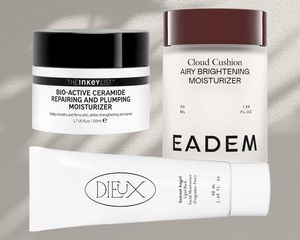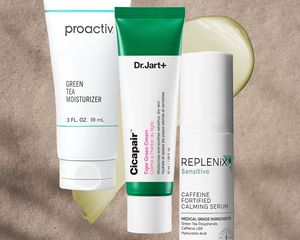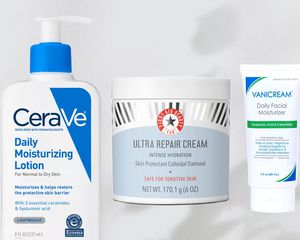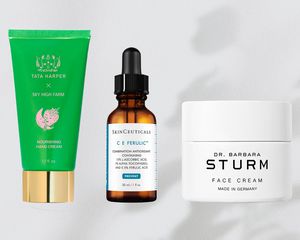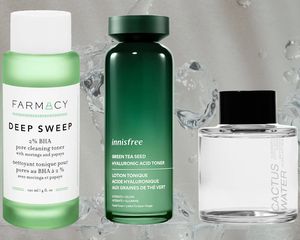:max_bytes(150000):strip_icc()/camellia-28cbfe450dbd4f789761fd6babfe4df7.jpg)
Getty Images
Quick question—have you ever heard of Camellia oleifera leaf extract or seen it listed in an ingredient label on your skincare products? If you're pretty positive you have, how sure are you that it wasn't actually Camellia oleifera seed oil or maybe even Camellia sinensis leaf extract? Not only can the plant be used and extracted in different ways, but according to research scientist Marisa Plescia, of clean beauty e-tailer NakedPoppy, "There are about 250 species of the genus Camellia that belong to the tea family." Kind of complicates things, right? To sort out the confusion, we turned to Plescia, as well as board-certified dermatologists Oma N. Agbai, MD, assistant clinical professor of dermatology at UC Davis; Nikhil Dhingra, MD, of Spring Street Dermatology in NYC; and Jaimie Glick, MD, of Marmur Medical. Below, the skin experts share their insight on Camellia oleifera leaf extract (as well as the other similar ingredients we also mentioned) and what you should know about using it for skin benefits.
Meet the Expert
- Marisa Plescia is a research scientist at clean beauty e-tailer NakedPoppy.
- Oma N. Agbai, MD, is a board-certified dermatologist and assistant clinical professor of dermatology at UC Davis.
- Nikhil Dhingra, MD, is a board-certified dermatologist at Spring Street Dermatology in NYC.
- Jaimie Glick, MD, is a board-certified dermatologist at Marmur Medical.
Camellia Oleifera Leaf Extract
Type of ingredient: Plant extract
Main benefits: Potentially provides antioxidant, anti-inflammatory, and antimicrobial effects on the skin.
Who should use it: Unless you have an allergy, Camellia oleifera leaf extract is generally suitable for most skin types.
How often can you use it: This depends on the product at hand and the manufacturer's instructions, but Plescia says Camellia oleifera leaf extract is generally safe to use in beauty products in any skin area.
Works well with: Plescia recommends using additional antioxidants, such as vitamin C, in conjunction with Camellia oleifera leaf extract, which could boost the potential skin benefits, such as reducing the signs of aging, including sun spots, fine lines, and wrinkles.
Don't use with: Plesica says it's safe to use in beauty products in any type of formula and can be used in conjunction with many cosmetic ingredients.
What Is Camellia Oleifera Leaf Extract?
As Plescia explains it, Camellia oleifera leaf extract is extracted from the leaves of the Camellia oleifera, a shrub of the tea family and a type of green tea that's native to Asia, especially southern China. According to Dhingra, tea leaves have been heralded for their polyphenol contents, a family of molecules with a pretty broad range of described health benefits.
For that reason, you'll find the ingredient in everything from serums and cleansers to moisturizers and masks. Plesica says personal care products will contain additional antioxidant protection for the formula and ingredients themselves, so when used in a complete and well-formulated cosmetic product, there should be no concerns in terms of packaging or storage.
Benefits of Camellia Oleifera Leaf Extract for Skin
As far as the proven benefits of Camellia oleifera leaf extract for the skin? More evidence is needed to say for sure. Dhingra says in addition to having antioxidant effects, which combat the effects of environmental and ultraviolet-induced skin damage, tea extract may inhibit some of the enzymes involved in degrading molecules like collagen, hyaluronic acid, and elastin, which can slow down signs of aging. He also adds that select molecules may have anti-inflammatory benefits as well, but it might be too soon to say just how much Camellia oleifera leaf extract can do for the skin. "Much of the supportive evidence comes from cell cultures and animal studies, and since these products aren't standardized, it's hard to truly determine the degree of benefit someone might get by introducing tea leaf extract into their routine," notes Dhingra.
Agbai points to one study that showed evidence that it may function as an antioxidant, which could reduce cellular damage that could lead to premature aging of the skin. "However, this was not shown in humans but in lab experiments," Agbai explains. "Because of this, I would be very cautious in suggesting that its use will benefit the skin."
Camellia Oleifera Leaf Extract vs. Camellia Sinensis Leaf Extract
Camellia sinensis is another type of tea plant, but both Camellia sinensis and Camellia oleifera have very similar properties. Plesica notes that these leaf extracts are said to contain powerful antioxidants and have anti-inflammatory and even antimicrobial properties.
Camellia Oleifera Leaf Extract vs. Camellia Oleifera Seed Oil
Although Camellia oleifera leaf extract and seed oil might seem similar enough, the terms aren't exactly interchangeable. Not to state the obvious, but the first difference is how they're extracted. As we mentioned before, the leaf extract comes from the leaves, while the seed oil is obtained from the dried kernels of the plant. Plescia points out that Camellia oleifera seed oil is often referred to as "tea seed oil" and has been used for centuries in skincare and even for cooking since it’s also edible.
Between the two, Plescia says Camellia oleifera seed oil, which penetrates quickly into the skin without leaving a greasy feel and is very stable against oxidation, is actually more commonly used in skincare products since it's very well-known and used for multiple benefits. "Camellia oleifera seed oil is actually pretty similar in its properties to olive oil," Plescia explains. It is rich in oleic acid (which is excellent for dry skin since it’s able to effectively replenish skin’s moisture and also prevent additional water loss, thanks to its occlusive properties) and linoleic acid (which can lead to skin rejuvenating properties). For these reasons, Plescia says Camellia oleifera seed oil is an excellent emollient. The seed oil also contains natural antioxidants, such as tocopherols (vitamin E) and polyphenols, which provide protection from environmental aggressors.
Glick says because of the anti-inflammatory and antioxidant properties, Camellia oleifera seed oil is appropriate for patients of all skin types, especially those with sensitive skin like rosacea or eczema; however, for acne patients, there is always a chance that oil can lead to increased comedogenesis, so she suggests those patients practice caution. If you decide to use products containing Camellia oleifera seed oil, Glick recommends first massaging a dime-size amount in the palms of your hands to create a thin spreadable layer before applying the oil to a cleansed face.
Side Effects of Camellia Oleifera Leaf Extract
Although Plescia says Camellia oleifera leaf extract is generally safe when used in skincare formulations, any skincare product, no matter how natural, can lead to an allergic or irritant contact reaction. "Even products used to treat rosacea can cause a rosacea flare," Glick explains. "Always start with a small spot on the face to assess your skin’s reactivity to a new product."
How to Use It
If you decide after reading all of the above information that you'd like to use a product containing Camellia oleifera leaf extract as a part of your daily routine, use the manufacturer's instructions for guidance on how and how often to apply the product. Plescia recommends combining the ingredient with other antioxidants, such as vitamin C, to boost any of the potential skin benefits, like the reduction of sunspots, fine lines, wrinkles, and signs of aging.
